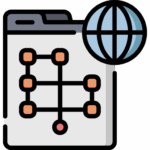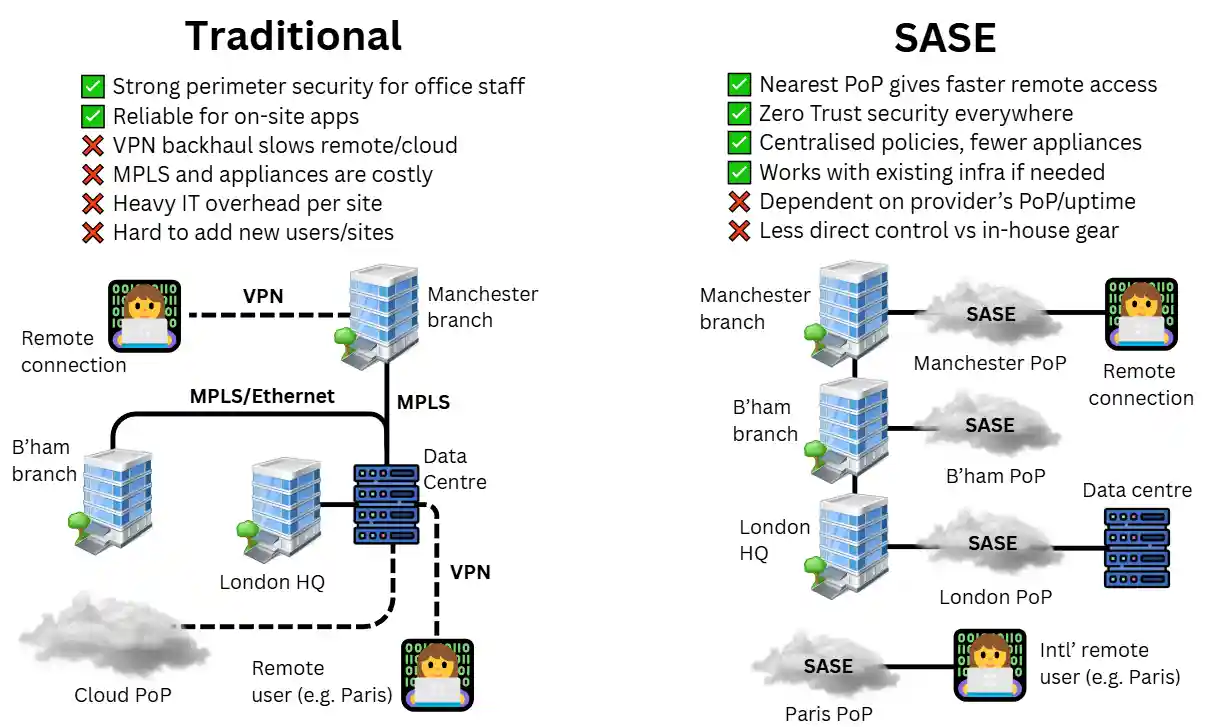Secure Access Service Edge (SASE) for businesses
Find out how SASE network architecture can benefit your business
Get an expert opinion today…
Find out how SASE network architecture can benefit your business
Get an expert opinion today…
Deploying SASE may sound complex, but our experts make the process straightforward. We take care of the design, configuration, and integration so your business can move to a more secure, cloud-based setup with confidence.

Start by contacting our team using the form above. We’ll arrange a consultation to understand your current infrastructure, security priorities, and how your teams connect across different sites or remotely.

Based on your requirements, our experts will design a tailored SASE implementation that balances performance, scalability, and protection. We’ll walk you through the setup process and provide clear pricing before anything moves forward.

Once approved, we’ll coordinate your SASE deployment, handling all technical stages from connection testing to live rollout. You’ll benefit from a fully managed transition with minimal disruption to your day-to-day operations.
We make it easy for UK businesses to upgrade to a SASE network that’s fast, secure, and tailored to their operations. Here’s why companies choose us for advanced network connectivity:

Our experts take time to understand how your business operates, recommending SASE only when it aligns with your existing network and security systems. Whether you need to connect multiple sites or support remote workers, your network will be built around your priorities.

We partner with leading SASE providers to ensure your organisation benefits from the latest in cloud-delivered security, including secure access, zero-trust protection, and encrypted traffic across all users and devices.

Our network experts are here to simplify every stage, from exploring options to full deployment. You’ll get clear advice, transparent pricing, and ongoing support.
Secure Access Service Edge (SASE) is a cloud-based network architecture that optimises and secures modern business networks that are built around remote employees and cloud services.
It unifies technologies like SD-WAN, Zero Trust Network Access, Secure Web Gateways, and cloud-based firewalls into a single service that protects users, applications, and data, wherever they’re hosted or accessed.
SASE contrasts with traditional setups that rely on VPN tunnels to safely connect users to their heavily fortified, yet inflexible business networks.
SASE isn’t inherently better or worse than those trusty traditional models; it’s just more suited to flexible teams that rely heavily on cloud services and apps.
In many cases, businesses roll out SASE alongside existing infrastructure to support more fluid operations and departments, enabling a smoother, phased transition into a modern, cloud-first setup.
SASE centralises all wide area network (WAN) functionality into a single, cloud-delivered service built around five core components:
SASE removes the need to backhaul traffic through headquarters via VPN to access advanced security or optimised routing. IT teams also avoid managing firewalls, routing rules, and access policies at every site.
Instead, routing, encryption, authentication, and traffic inspection are all defined once and applied consistently to every user, device, and location from the cloud.
Here’s how the key components come together in practice:
SD-WAN solutions optimise business internet connections by continuously selecting the most efficient path for its traffic.
For example, a remote worker’s connection to a cloud CRM might be routed through the nearest branch office (i.e. like a traditional VPN) if that path offers lower latency than connecting via the closest cloud access point (PoP).
SD-WAN also provides built-in failover capabilities. If the point-to-point leased line between headquarters and a branch office goes down, the system can instantly switch to a backup fibre connection to maintain service continuity.
All of these routing decisions happen simultaneously and in real time. SD-WAN can even distinguish between different types of traffic (e.g. VoIP calls, video conferences, or large file backups), ensuring each is routed in the most effective way.
💡 Read our in-depth SD-WAN explainer to learn more about this disruptive routing technology.
Before any data flows, SASE makes sure Zero Trust Network Access (ZTNA) verifies the user, device, and context.
For example, Salesforce access could be configured so that users can only log in from corporate devices, even if they have the correct credentials and multi-factor authentication.
ZTNA continuously verifies that access conditions are met. Changing to an unauthorised WiFi or a backup line terminates the session.
And because ZTNA feeds into SD-WAN, only authenticated and approved sessions are optimised.
Once the connection is established, Secure Web Gateways (SWG), firewalls-as-a-service (FWaaS), and Cloud Access Security Brokers (CASB) filter and protect the session:
These aren’t standalone tools, but are orchestrated by the SASE platform. Policies are applied dynamically, based on identity (ZTNA) and routing (SD-WAN), ensuring the right security controls are enforced at the right moment without slowing users down.
Traditional network architectures are designed for on-site work and applications residing in a company’s data centre. Network security is enforced through a defined perimeter of firewalls, VPNs, and web gateways, and in that context, the model is very effective.
However, modern work environments rely on cloud platforms such as Microsoft 365 and Salesforce that sit outside the traditional perimeter. At the same time, employees access them from homes, client sites, and international locations, not only from the office.
Routing all traffic through company servers via VPNs introduces latency and increases the workload of IT staff. In this context, actors like remote developers and international consultants face slower, less secure connections compared to office-based staff, and often run into annoying access restrictions.
Secure Access Service Edge (SASE) flips this model by relocating networking and security into the cloud. Instead of backhauling traffic through company servers, users gain performance and secure access by connecting to the nearest SASE point of presence (PoP).
In the UK, SASE providers such as Zscaler, Palo Alto, and Cisco maintain access nodes in major cities like London, Manchester, and Birmingham to deliver consistent nationwide coverage.

Most organisations today operate in a hybrid state, blending elements of both approaches as they gradually modernise.
The table below summarises the key differences for users in both networks:
| Scenario | Traditional Network | With SASE |
|---|---|---|
| Cloud access | Traffic often backhauled through HQ firewalls, adding latency before reaching apps like Microsoft 365 or Salesforce | Traffic sent directly to apps via nearest PoP; performance improves but still depends on PoP coverage and internet quality |
| Branch office connectivity | VPNs or MPLS tunnels route users back to the corporate data center | Users connect to local PoP for secure access; reduces reliance on HQ but requires strong PoP footprint |
| Security enforcement | Perimeter-based, concentrated at main site | Distributed, cloud-based enforcement at each PoP for consistent policy application |
| User experience | Variable. Office staff have optimal connectivity and security; but remote users often slower, less consistent | Generally smoother and more scalable, though performance varies by provider coverage and user location |
| IT overhead | Heavy appliance management, patching, and VPN troubleshooting | Centralised, cloud-managed policies reduce infrastructure burden but shift control to provider |
| Adoption reality | Widely deployed; proven but increasingly outdated for cloud-first workforces | Growing adoption; many organisations run hybrid models during transition |
Unlike what many vendors and network providers claim, SASE is not a universal solution that every business needs.
Its cost is only justified when the scale, complexity, and risk profile of a network make traditional or consumer-grade approaches unworkable.
For small teams, such as marketing agencies that rely on basic cloud tools like Google Docs, Sheets, or Canva, SASE is unnecessary. Strong passwords, multi-factor authentication, and endpoint protection already provide sufficient security and usability.
Where SASE delivers real value is in larger or more complex organisations that:
These are businesses where network demands and risk exposure exceed the limits of perimeter firewalls and VPNs.
Here are some examples of businesses that are moving into SASE and why:
| Business | Why is SASE for them |
|---|---|
| Mid-sized manufacturer | Because managing dozens of sites with hundreds of separate firewalls and VPNs created inconsistent policies and high upkeep. SASE let them centralise policy control in the cloud, remove most on-prem appliances, and reduce long-term costs. |
| Mid-sized FinTech | Because their reliance on SaaS and cloud platforms made backhauling all traffic through HQ VPNs slow and troublesome. With SASE, staff accessed apps like Salesforce and AWS through local PoPs, with Zero Trust access meeting regulatory standards. |
| Large logistics operator | Because depots and warehouses depended on fragmented firewalls and site-to-site VPNs that were difficult to manage consistently. SASE provided secure, direct access from depots, drivers, and offices to central supply chain systems under one policy framework. |
| NHS healthcare provider | Because clinics and practitioners needed reliable access to patient records, but legacy VPNs were hard to scale and raised compliance concerns. SASE enforced uniform data protection policies across all sites and improved secure access to cloud-based EHR systems. |
SASE brings together performance, security, and scalability in a single cloud-delivered service, giving organisations a network that keeps pace with modern workflows.
Instead of patching together VPNs, firewalls, and appliances across offices, IT teams define policies once in the cloud, and users enjoy fast, secure access wherever they are.
It future-proofs businesses by making it easier to adopt the latest tools and platforms without re-engineering the network each time.
Here are the key benefits, with tangible examples of the impact:

SASE reduces latency for remote teams and cloud-heavy organisations by allowing users to connect to the nearest point of presence rather than backhauling traffic through an office.
This makes a measurable difference when staff are spread across regions and rely on platforms like Salesforce or Microsoft 365.
For example, a mid-sized UK fintech could improve Salesforce and AWS performance for employees in continental Europe by routing traffic through local PoPs instead of via its London HQ.

SASE strengthens security for organisations with users working outside secure office networks. Instead of relying on VPNs that grant broad access once connected, SASE applies Zero Trust policies that continuously verify user identity, device, and context.
For instance, a private healthcare group with multiple UK clinics could use SASE to ensure practitioners accessing patient records from branches or from home were subject to the same strict controls as those working onsite.

SASE simplifies IT operations for businesses managing multiple sites or complex toolsets. It consolidates firewalls, VPNs, and secure web gateways into a single cloud-managed platform, reducing overhead and inconsistencies.
A UK manufacturer with several plants could replace dozens of separate firewalls with centralised policies defined once in the cloud, cutting maintenance overhead and ensuring consistency.

SASE supports growth for organisations that frequently add new branches, contractors, or workloads.
New users or sites connect securely through the nearest PoP without requiring new appliances or complex configuration. Many working in large enterprises have grappled with the IT bureaucracy of secure yet cumbersome links with third parties.
A UK logistics operator expanding into new depots could enable secure access for staff and drivers without needing to install local firewalls at each site.

SASE helps regulated industries such as finance, healthcare, and legal by applying uniform security controls and generating audit-ready logs across all users and locations.
For example, a financial services firm with offices in London and Dublin could use SASE to ensure GDPR-compliant access to sensitive data, with audit trails that regulators can trust.

SASE reduces costs for organisations weighed down by appliance-heavy networks. By retiring VPN concentrators, some on-site firewalls, and leased MPLS circuits, these businesses can cut hardware refresh cycles and simplify licensing into a single subscription.
A UK professional services company could achieve significant savings by consolidating multiple network security contracts into a single SASE platform.
On paper, most SASE vendors promise the same things: “global coverage”, “Zero Trust”, and “five nines” uptime.
In practice, the differences lie in how well the service aligns with your organisation’s network footprint, compliance obligations, and operational practices. Here are the main points to consider when choosing a provider:

SASE performance really depends on where users connect. A provider with PoPs in London but not in Manchester or Birmingham will deliver a very different experience for staff outside the capital.
For organisations with overseas teams, global coverage matters just as much. The best providers show you exactly where their PoPs are and let you test performance before committing.

A UK PoP does not automatically mean UK data residency. Many vendors still process logs or telemetry outside the country.
For sectors such as finance, healthcare, or legal, this distinction matters. Providers should be able to demonstrate GDPR alignment, explain their data flows, and provide certifications such as ISO 27001 or SOC 2.

For most businesses, the biggest performance issues are around Microsoft 365, Google Workspace, AWS, or Azure.
A strong SASE platform doesn’t just secure these services; it optimises access to them. Features such as Microsoft 365 ExpressRoute integration or CASB visibility into SaaS traffic directly translate into a smoother user experience.

Every vendor advertises near-identical uptime guarantees, so Service Level Agreements (SLAs) alone are not a differentiator.
The real test is the provider’s support. Enquire about their response times, escalation paths, and whether you can get someone in-region on the phone when it matters.
In this respect, a UK-based managed service partner can make a significant difference in day-to-day operations.

SASE is often sold in multi-year bundles, but not all pricing models fit every organisation.
Some charge per user, others by bandwidth, and some include advanced services that many businesses will never need. The key is transparency. A provider willing to pilot, phase deployment, or offer flexible terms is usually the safer long-term choice.

Experience in the sector your business operates in is important. A provider that has delivered SASE to financial services firms, healthcare groups, or professional services companies will have already solved many of the industry’s compliance and operational hurdles.

SASE can be delivered through different channels. Global vendors such as Zscaler or Palo Alto operate their own platforms, while the enterprise arm of telecom carriers like BT often bundle SASE with connectivity.
Many organisations instead work with managed service providers or integrators who deploy and operate vendor platforms on their behalf.
Choosing the right SASE provider ensures your business gets the best balance of performance, control, and support. We work with trusted UK and global partners delivering secure, cloud-based networking to suit every scale of business.

A global SASE leader recognised for advanced Zero Trust security and seamless cloud integration. Ideal for larger businesses prioritising protection and scalability.

Delivers enterprise-grade security with smooth integration into existing Palo Alto hardware, such as firewalls and routers.

Known for strong CASB and SaaS visibility, trusted across compliance-heavy industries such as finance and healthcare.

Combines proven SD-WAN expertise with robust cloud security. Powers many managed and telecom-based SASE deployments.

Built on one of the world’s largest edge networks for outstanding speed and reliability. Known for quick setup and low latency.

A cloud-native challenger combining integrated SD-WAN and security on its own private global backbone
SASE services are delivered through different provider models, each offering a distinct balance of control, flexibility, and management. Understanding these types helps you choose the right fit for your organisation’s size, resources, and security needs.
Global vendors develop and operate their own SASE platforms, managing every aspect of performance, innovation, and security.
Telecom and carrier providers integrate SASE into their broadband, WAN, and business VoIP solutions, delivering unified connectivity and security under one contract. Examples include BT Business, Vodafone Business, and Virgin Media O2 Business.
MSPs deliver SASE as a managed service, handling design, deployment, and ongoing optimisation for your business.
Leading SASE-focused MSPs in the UK include:
Our business broadband experts answer the following frequently asked questions about SASE:
Yes. Most organisations adopt SASE in stages, running it alongside existing VPNs and firewalls. This hybrid approach enables IT teams to prioritise moving critical apps and remote staff, followed by extending SASE to other sites over time.
Yes. SASE deployments require careful design and planning. Challenges include integrating with legacy systems, defining new Zero Trust policies, ensuring user adoption, and avoiding misconfigurations. Costs can be front-loaded, though many organisations recoup them through reduced hardware spend and IT overhead later.